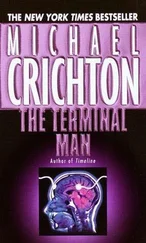“Senhor!” shouted Stone, over the noise of the rotors. “What was that? Were they—”
Stone’s voice cut out as the pilots turned to him.
It was the naked fear on the faces of what he would later describe as “hard men” that took Stone’s breath away. And at that moment, some symmetry in the twisting shapes he had seen coalesced in his mind.
The pilot and copilot tossed out Stone’s black hard-case luggage. Stone hastily gathered his papers, snatched up his duffel bag, and got to his feet. He stood in the open doorway for a moment, a lean silhouette against the crimson sunlight outside.
Stone turned to the pilot, his voice hollow as he spoke. “Those were monkeys, weren’t they? Swinging through the upper branches in a panic. Hundreds of them. A thousand.”
The pilot said nothing, emotionless behind mirrored sunglasses. Without warning, his copilot took hold of Stone’s shoulders and roughly shoved him through the helicopter door. He tumbled out and fell to his knees on the muddy ground.
The Sikorsky had already lifted off before Stone could get to his feet.
Boots on the Ground Boots on the Ground Noon Field Briefing Manifest Day 2: Wildfire Dawn Discovery Twenty-Mile Perimeter A Higher Analysis Incomplete Information Second Camp Day 3: Anomaly Night Ambush Alpha and Omega In the Morning Light Outcomes Indios Bravos First Contact Plan B The Anomaly Fail-Safe Day 4: Breach Operation Scorched Earth Dawn Strike Entry Primary Descent Evolutions Forensics Fight or Flight State of Emergency The Tunnel Best-Laid Plans Inundation Activation Day 5: Ascent A New Paradigm Finger of God Realignment Z-Axis Mission Preparation Destination ISS Docking Procedure Stone’s Theory Reunited Goodbyes Intercepted Transmission Super-Terminal Velocity Resolution Out of Eden Epilogue Footnotes References Keep Reading … About the Authors Also by Michael Crichton About the Publisher
DR. NIDHI VEDALA WAS ANGRY. AND IMPATIENT. SWATTING at a mosquito with one hand, she heard the thundering approach of the Sikorsky H-92 and her dark eyebrows knit together in a frown. The makeshift clearing around her was scattered with muddy black hard-case luggage, each containing precious equipment that needed to be checked for damage. The noise and commotion of incoming rotors sent squawking birds streaking past her and startled a young caiman on the riverbank into the water.
She ignored it all, consciously forcing herself to unclench her fists and continue inspecting the hard-cases. The jungle didn’t frighten her. Not much did.
Vedala had grown up an orphan in the Morarji Nagar slums of Mumbai, a member of the Dalit social caste—called the “untouchables,” often beaten and discriminated against. Though impoverished, she saw the world with the clear focus of a naturally keen intellect. Even as a bone-thin child under a mop of reddish-black hair, she never had a doubt that she would someday escape the narrow alleyways, fetid community toilets, and sickening miasma of the toxically polluted Mithi River.
During her first round of mandatory statewide merit testing, Nidhi had come away with the top score out of approximately fifteen million school-age Indian children. Starting from nothing, she had painstakingly earned her place among these distinguished scientists on this high-stakes mission.
The leader of the expedition and a founding member of the next generation Project Wildfire, Vedala had been dragged away from her laboratory at the Massachusetts Institute of Technology by armed goons, driven an hour to Hanscom Air Force Base, and placed on board a wildly inappropriate C-130 Hercules military jet. Her mobile phone and laptop were confiscated, along with her identification. The cargo plane had been fueled up and waiting on the tarmac, but still set in an armored vehicle transport configuration, with only a few jump seats available for passengers.
None of this had startled her in the least.
Vedala was a small woman with an impish face and an efficient pixie haircut. She often scowled while concentrating, unconsciously intimidating others. She wasn’t tall, but nonetheless projected a large presence, and her military escort quickly decided to retire to the cockpit up front with the two pilots and loadmaster. For the next twelve hours Vedala sat alone in the cavernous belly of the great beast, sleeping occasionally, but mostly rereading a fat red packet of files by the stark glow of the interior floodlights.
From the first moment, she understood that only one type of threat could possibly justify this level of expenditure—it had to be a global crisis with existence-level repercussions. A true world-ending scenario.
And Vedala welcomed it.
This was, after all, exactly the situation to which she had devoted her career. A materials scientist with a nanostructure specialty, she had spent her public life rising meteorically through the ranks of academics.
Her relentless exploration of new metamaterials had exploited the quirks of quantum mechanics to miraculous effect. Among the many discoveries made in her laboratory were novel materials that could absorb electromagnetic energy to render a perfect retina-draining blackness, or allow light in the visible spectrum to slide away entirely in a blurry sort of invisibility cloak, or imbue a surface with perfect smoothness, a near-zero friction to which no viscous liquid could stick.[fn1]
But Vedala’s true career had not taken place in the public eye.
Early on she had been approached by a major general in the US Air Force, an ambitious former fighter pilot named Rand L. Stern who had transitioned to a faculty position at the US Military Academy at West Point with a specialization in theoretical mathematics.
At that time in her life, Vedala hadn’t known that academics and the military could mix. But the determined general wouldn’t be ignored. He told Nidhi that her expertise was needed for a historically momentous project, and all she had to do was sign on the dotted line. He mentioned she had already passed every background check and intelligence test that his analysts could administer.
Vedala had only blinked at this information.
She had not been aware that she was under any scrutiny. Now, she wondered at just how specific the New York Times crosswords had been getting the last few weeks, and she began to question the increasingly complex problems her graduate students had been bringing to their office visits.
In any case, Vedala had never failed a test in her life.
Choosing to accept Stern’s offer of military clearance, she had listened intently to every detail of the incident in Piedmont, Arizona. When it was over, she understood her role perfectly.
At first assumed to be an organism, the Andromeda Strain actually seemed to have more in common with a new area of science—nanotechnology, the study of machines less than one hundred nanometers in size.
Vedala had devoted her career to understanding the topography of nanoscopic structures, and the construction of artifacts small enough to fit on a pinhead (along with however many angels wished to dance there). She knew there was vast potential waiting for humankind in the realm of nanoscale. After a single conversation with Stern, it became her life’s work to understand this mysterious extraterrestrial microparticle.
So far, her studies had been a resounding success.
Vedala’s most brilliant insight had been to expose the two varieties of Andromeda to each other. Studying the results at a nanoscale, she discovered that each strain ignored the presence of the other. As close cousins, the substances seemed to have entered into a kind of noncompete agreement.
Essentially, AS-1 and AS-2 were invisible to each other.
Realizing this, Vedala had been able to mass-produce a spray coating with a nanostructure mimicking the contours of both Andromeda strains, creating a surface that was nonreactive to both. Vedala’s brilliance did not extend to naming her creation, however; the antibonding mechanism was dubbed simply “aerosolized nanocrystalline cellulose-based Andromeda inhibitor.”
Читать дальше








